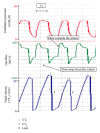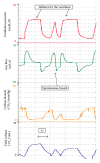Noninvasive Monitoring during Interhospital Transport of Newborn Infants
- PMID: 23509618
- PMCID: PMC3595700
- DOI: 10.1155/2013/632474
Noninvasive Monitoring during Interhospital Transport of Newborn Infants
Abstract
The main indications for interhospital neonatal transports are radiographic studies (e.g., magnet resonance imaging) and surgical interventions. Specialized neonatal transport teams need to be skilled in patient care, communication, and equipment management and extensively trained in resuscitation, stabilization, and transport of critically ill infants. However, there is increasing evidence that clinical assessment of heart rate, color, or chest wall movements is imprecise and can be misleading even in experienced hands. The aim of the paper was to review the current evidence on clinical monitoring equipment during interhospital neonatal transport.
Figures






Similar articles
-
Interhospital Transport of Pediatric Patients in Denmark: A Survey of Current Practice.Pediatr Emerg Care. 2020 Aug;36(8):389-392. doi: 10.1097/PEC.0000000000001586. Pediatr Emerg Care. 2020. PMID: 30211832
-
A National Survey on Interhospital Transport of Children in Cardiac Arrest.Pediatr Crit Care Med. 2019 Jan;20(1):e30-e36. doi: 10.1097/PCC.0000000000001768. Pediatr Crit Care Med. 2019. PMID: 30395025
-
Resuscitation, stabilization, and transport in perinatology.Curr Opin Pediatr. 1993 Apr;5(2):150-5. doi: 10.1097/00008480-199304000-00003. Curr Opin Pediatr. 1993. PMID: 8374633
-
European consensus recommendations for neonatal and paediatric retrievals of positive or suspected COVID-19 patients.Pediatr Res. 2021 Apr;89(5):1094-1100. doi: 10.1038/s41390-020-1050-z. Epub 2020 Jul 7. Pediatr Res. 2021. PMID: 32634819 Review.
-
Expanding the role of the neonatal transport nurse: nurse-led teams.Br J Nurs. 1997 Jul 24-Aug 13;6(14):800-4. doi: 10.12968/bjon.1997.6.14.800. Br J Nurs. 1997. PMID: 9283304 Review.
References
-
- O’Reilly M, Schmölzer GM. Monitoring during Neonatal transport. Emergency Medicine. 2012;1
-
- Stroud MH, Prodhan P, Moss M, Fiser R, Schexnayder S, Anand K. Enhanced monitoring improves pediatric transport outcomes: a randomized controlled trial. Pediatrics. 2011;127(1):42–48. - PubMed
-
- Meberg A. Neonatal transports—risks and opportunities. Open Journal of Pediatrics. 2011;1:45–50.
-
- Kempley ST, Ratnavel N, Fellows T. Vehicles and equipment for land-based neonatal transport. Early Human Development. 2009;85(8):491–495. - PubMed
-
- Jackson L, Skeoch CH. Setting up a neonatal transport service: air transport. Early Human Development. 2009;85(8):477–481. - PubMed
LinkOut - more resources
Full Text Sources
Other Literature Sources

